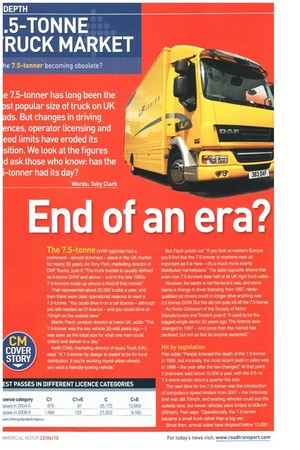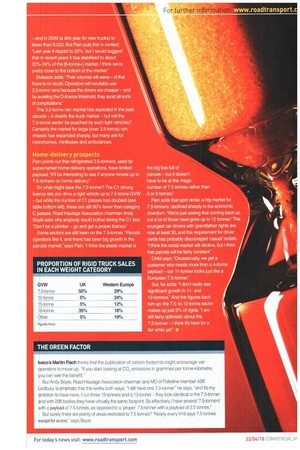End of an era?
Page 38

Page 39

If you've noticed an error in this article please click here to report it so we can fix it.
The 7.5-tonne GVW rigid has had a prominent — almost dominant — place in the UK market for nearly 30 years. As Tony Pain, marketing director of DAF Trucks, puts it: "The truck market is usually defined as 6-tonne GVW and above — and in the late 1980s 7.5-tonners made up almost a third of that market:.
That represented about 20,000 trucks a year, and then there were clear operational reasons to want a 7.5-tonner."You could drive it on a car licence — although you still needed an 0-licence — and you could drive at 70mph on the outside lane"
Martin Flach. product director at Iveco UK, adds: The 7 5-tonner was the key vehicle 20-odd years ago — it was seen as the ideal size for what one man could collect and deliver in a day."
Keith Child, marketing director of lsuzu Truck (UK), says* "A 7.5-tonner by design is meant to be for local distribution. If you're working round urban streets you want a friendly-looking vehicle." But Flach points out: "If you look at western Europe, you'll find that the 7.5-tonner is nowhere near as important as it is here — it's a much more evenly distributed marketplace." The table opposite shows that even now 7.5-tonners take half of all UK rigid truck sales.
However, the sector is not the force rt was. and some blame a change in driver licensing. from 1997. newlyqualified car drivers could no longer drive anything over 3.5 tonnes GVW. But this did not quite kill off the 7 5-tonner As Robin Dickeson of the Society of Motor Manufacturers and Traders puts it: "It used to be the biggest single sector 20 years ago. The licence laws changed in 1997 — and since then the market has declined, but not as fast as anyone expected:
Hit by legislation
Pain adds: "People forecast the death of the 7.5-tonner in 1995, but ironically, the most recent peak in sales was in 1998 — the year after the law changed." At that point, 7.5-tonners sold about 15.000 a year. with the 3.5to 7.4-tonne sector about a quarter the size The next blow for the 7.5-tonner was the introduction of compulsory speed limiters from 2007 — the motorway limit was still 70mph. and existing vehicles could use the outside lane, but newer vehicles were limited to 90km/h (56mph). Pain says. -Operationally. the 7.5-tonner became a small truck rather than a big van" Since then, annual sales have dropped below 10,000 — and in 2009 (a dire year for new trucks) to fewer than 6,000. But Pain puts this in context: "Last year it dipped to 20%, but I would suggest that in recent years it has stabilised to about 22%-24% of the [6-tonne+1 market I think we're pretty close to the bottom of the market' Dickeson adds: -Their volumes will wane — of that there is no doubt. Operators will inevitably use 3.5-tonne vans because the drivers are cheaper — and by avoiding the 0-licence threshold, they avoid all sorts of complications."
The 3.5-tonne van market has exploded in the past decade — it dwarfs the truck market — but will the 7.5-tonne sector be poached by such light vehicles? Certainly the market for large (over 3.5-tonne) van chassis has expanded sharply, but many are for motorhomes, minibuses and ambulances.
Home-delivery prospects
Pain points out that refrigerated 3.5-tonners, used by supermarket home-delivery operations. have limited payload. "It'll be interesting to see if anyone moves up to 7.5-tortners on home delivery:'
So what might save the 7.5-tonner? The Cl driving licence lets you drive a rigid vehicle up to 7.5-tonne GVVV — but while the number of Cl passes has doubled (see table bottom left), these are still 90% fewer than category C passes. Road Haulage Association chairman Andy Boyle asks why anybody would bother taking the Cl test: -Don't be a plonker — go and get a proper licence."
Some sectors are still keen on the 7,5-tonner. -Parcels operators like it, and there has been big growth in the parcels market? says Pain. "I think the stable market is
the big box full of
parcels — but it doesn't
have to be at the magic number of 7.5 tonnes rather than 8 or 9 tonnes."
Pain adds that spot rental, a big market for 7.5-tonners. declined sharply in the economic downturn. "We're just seeing that coming back up.
but a lot of those have gone up to 12 tonnes." The
youngest car drivers with grandfather rights are now at least 30. and the requirement for driver cards has probably discouraged 'casual' rentals.
"I think the rental market will decline, but I think
that parcels will be fairly constant."
Child says: "Occasionally, we get a customer who needs more than a 4-tonne
payload — our 11-tonner looks just like a
European 7.5-tonner."
But, he adds: "I don't really see significant growth in 11and 12-tonners." And the figures back him up: the 7.5to 12-tonne sector makes up just 5% of rigids. 'I am still fairly optimistic about the
7.5-tonner — I think it's here for a
fair while yet." IN
































































































































